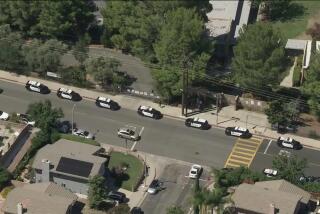New Funds Fuel Anti-Gang Efforts by Police, Schools
- Share via
LONG BEACH — Gangs are in for a fight from the city and the school district, as both gear up to implement recently approved grants to steer street-savvy kids away from trouble as early as the fourth grade.
While the Long Beach Unified School District prepares a course called Alternatives to Gang Membership with a $175,000 state grant, the Police Department will begin adding personnel to its gang unit with a $199,237 grant.
Some critics, who have charged that the city has not done enough to fight street gangs, say the two grants could signify a change in attitude by Long Beach officials.
“It’s about time,” said Barbara Shoag, who chaired the city’s Public Safety Advisory Commission in late 1985, when the group recommended more than two dozen proposals to thwart groups such as the Eastside Longos and the Insane Crips. “It’s a beginning.”
Implementing a school anti-gang program--patterned after a project in Paramount to teach elementary school children to stay away from gangs--and expanding the city’s two-officer gang unit were among recommendations from Shoag’s group in December, 1985.
At the time, the City Council stopped short of endorsing any of the recommendations; instead, it agreed to have its Public Safety Committee study the issue. Since then, the council also has appointed a mayor’s task force on gangs and substance abuse.
Mayor Ernie Kell earlier this week said city officials have “never denied that there’s a gang problem.” The programs, he said, are not a change of philosophy, but “stepped-up activity.”
New Programs Welcome
But for Shoag and others who have complained that not enough is done to rid the streets of gangs, their graffiti and their violence, the new programs are a change they hope will make the difference.
“Finally, the school district has acknowledged that there is a gang problem and the new administration, Mr. (Tom) Giugni (the district’s new superintendent) and his fellow administrators are dealing with the problem,” said Shoag, also a member of the mayor’s task force.
On Tuesday, the City Council approved the first appropriation of the city grant from the Office of Criminal Justice Planning. The money will add one extra police officer, one non-sworn police service assistant and one clerk-typist to the three-man unit, said Deputy Chief Bill Ellis.
Gang Homicides Down
Although police do not keep statistics on the percentage of crimes that are gang-related, they estimate an increase in such crimes in recent years. Officer Norm Sorenson, one of the two officers on the gang detail unit, said gang crimes “go in peaks and valleys.” In 1987, he said, they seemed to have decreased. For instance, there have been only three gang-related homicides so far this year. In 1986, there were 16 gang-related homicides, and 15 in 1985. The previous peak was nine, in 1983.
The addition of one officer, Sorenson said, “is a step in the right direction. It will make a significant impact.”
On the school level, officials are interested in steering children away from a life on the streets before they become members of one of Long Beach’s 22 active gangs.
By this fall, four elementary schools--Emerson, Muir, Starr King and Patrick Henry--will teach fourth-graders a course patterned after Paramount’s Alternatives to Gang Membership, said Karla S. Taylor, the district’s program specialist in charge of drug and gang-violence suppression plans.
The schools, selected from different parts of the city, were picked from Long Beach’s 52 elementary schools in part because they are in locations where gangs thrive and because “the principals there expressed very strong interest,” Taylor said.
Eventually, school officials would like to implement the program in all the elementary schools, said Robert Hart, head of the district’s special programs. The school grant--also from the state’s Office of Criminal Justice Planning--will pay for three additional teachers and will soon be complemented with a $50,000 grant that the district expects from the Los Angeles County Probation Department, Hart said.
Agencies Cooperating
Cooperation between the county’s Probation Department, the city’s Parks and Recreation Department and other agencies give the city and the district a “united front approach” against gangs, Hart said.
School officials also plan to strengthen the discipline and dress codes to forbid attire identified with gangs, Hart said.
“Some of these things are quite subtle. I heard certain kinds of shoelaces (denote a gang member). Well, who would think of something like that in a dress code?” Hart asked.
Teachers in the elementary as well as secondary level also will be taught to identify those who may be in gangs and how best to help the students, Taylor said.
Police estimate gang membership at about 2,700 in Long Beach; until last year, police gave estimates of 5,000 members. The different numbers, however, do not mean almost half of the gang members have left the city, Ellis said. “Our record-keeping has become more sophisticated. We are better at identifying the people involved and we purged out our files,” of people no longer involved in area gangs, Ellis said, adding that the numbers can rapidly change.
School officials hope to reach children with their anti-gang message before police need to become involved.
“Fourth grade is the first year of the pre-adolescence period. That’s when they become more interested in what their peers think than what adults think,” Hart said. “We’ll try to get the youngsters before they get involved in gang membership. By the time they reach junior high school, they’re already in gangs.”
More to Read
Sign up for Essential California
The most important California stories and recommendations in your inbox every morning.
You may occasionally receive promotional content from the Los Angeles Times.










